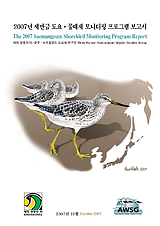Birds Korea works for the conservation of birds and their habitats through research, education and public-awareness raising activities, consultation and collaboration, and well-focused advocacy. Examples of our work within South Korea up to and during 2007 have been well-covered by both domestic and international media, and include:
Research:
The Saemangeum Shorebird Monitoring Program − involving over 70 researchers and volunteers in intensive counting of shorebirds at Saemangeum and the adjacent Geum Estuary and Gomso Bay in 2006 and 2007 alone;
Counts of shorebirds and waterbirds at other key sites, such as Song Do and Mokpo Urban wetland;
Gathering of records of key species, such as Spoon-billed Sandpiper, and of flags and colour bands, for national and international databases;
Repeat counts of migrant birds on the Yellow Sea Islands of Eocheong (Gunsan), and Socheong (Incheon), with publication of selected results in an international refereed journal;
Review of historic literature, leading to the development of a comprehensive checklist of the birds of the Korean peninsula;

On H5N1 Poultry Flu, review (and translation) of literature, and participation in FAO emergency mission (December 2006), and the Ramsar Science and Technical Review Panel meeting in Changwon, November 2007.
Education and Public-Awareness Raising:
Training camps and seminars on bird monitoring and bird conservation at the Nakdong Eco-centre, the Geum River Basin office of the Korea Wetlands Project, and at several universities nationwide;
Environment-education camps for school-children at Upo Ramsar site and Joonam reservoir;

Assistance with Shorebird-photograph displays at Wonkwang University and Mokpo Natural History Museum;

Production of online and other educational materials;
Consultation and Collaboration:
Discussion with several local specialists, government bodies and staff of conservation initiatives, on subjects ranging from eco-parks and eco-centres, to proposals for developing birdwatching based eco-tourism and regional planning initiatives;
Collaboration with local groups conducting survey work (e.g. in the Nakdong Estuary and Gomso Bay), with institutions (such as universities and the Mokpo Natural History Museum), with national groups (e.g. gathering petitions against the Saemangeum reclamation, and preparing for the Ramsar Convention conference in 2008), with national government bodies (e.g. the three offices of the Korea Wetlands Project, under the auspices of the Ministry of Environment; and the Yellow Sea Partnership); and with NGOs overseas (e.g. forming a formal partnership with the Australasian Wader Studies Group; inviting and hosting researchers from Thailand and Bangladesh in April and May 2007; and developing joint press releases with the UK's RSPB).

Advocacy:
We have worked tirelessly for species of special conservation concern and threatened internationally important wetlands/Important Bird Areas, at e.g. Saemangeum, the Geum Estuary, the Nakdong Estuary, Song Do in Incheon and Seongsan Po in Jeju, through website-broadcast, mailing, meetings and media;
We have produced several publications, including attractive and data-rich SSMP reports and newsletters, and posted several key documents online, relating to strategies for the long term conservation of birds and wetlands in Korea;
We have supported international email campaigns (such as at: www.restoresaemangeum.com);
We have participated actively in the international discussion on Korean bird and wetland conservation, through visits to embassies, overseas presentations, attendance of Convention meetings, regular emailing with leading conservation organizations, and international media coverage.
For more on the rationale for our conservation work, please go to:
Further Background Information on The Conservation Work of Birds Korea






